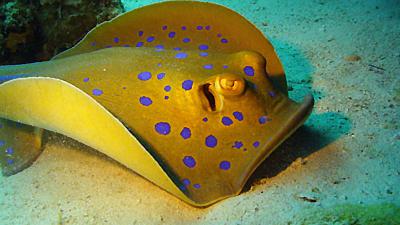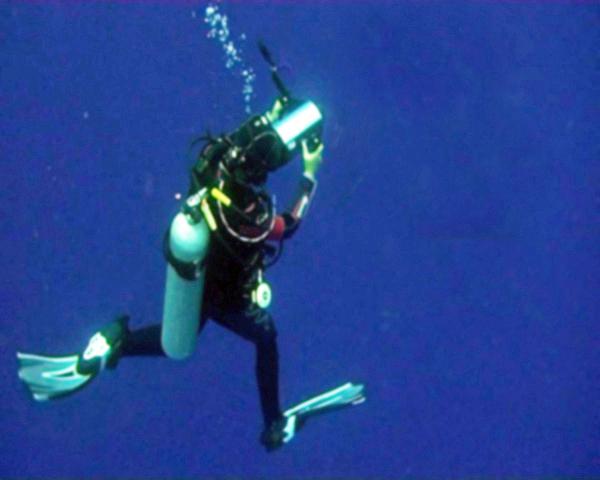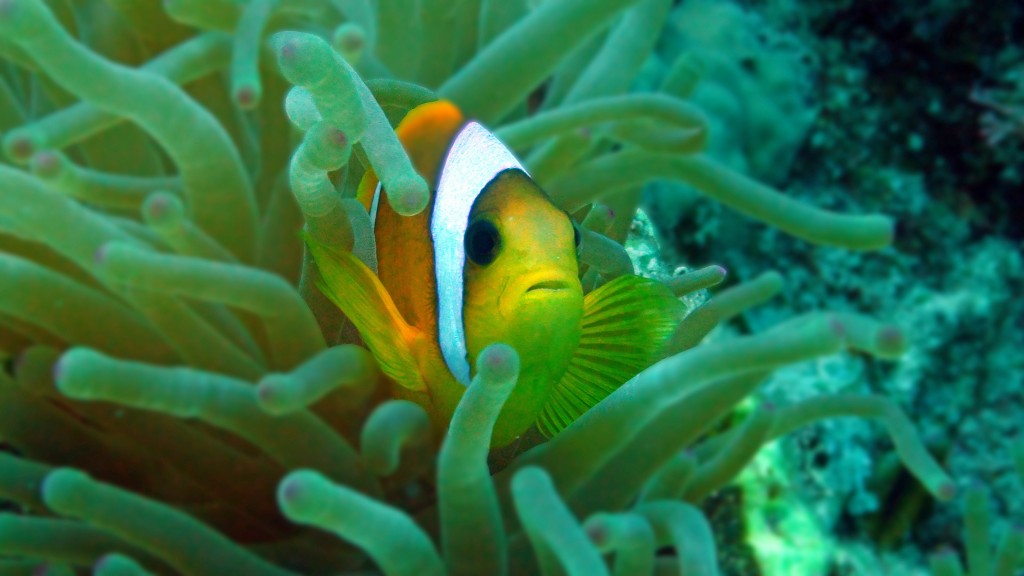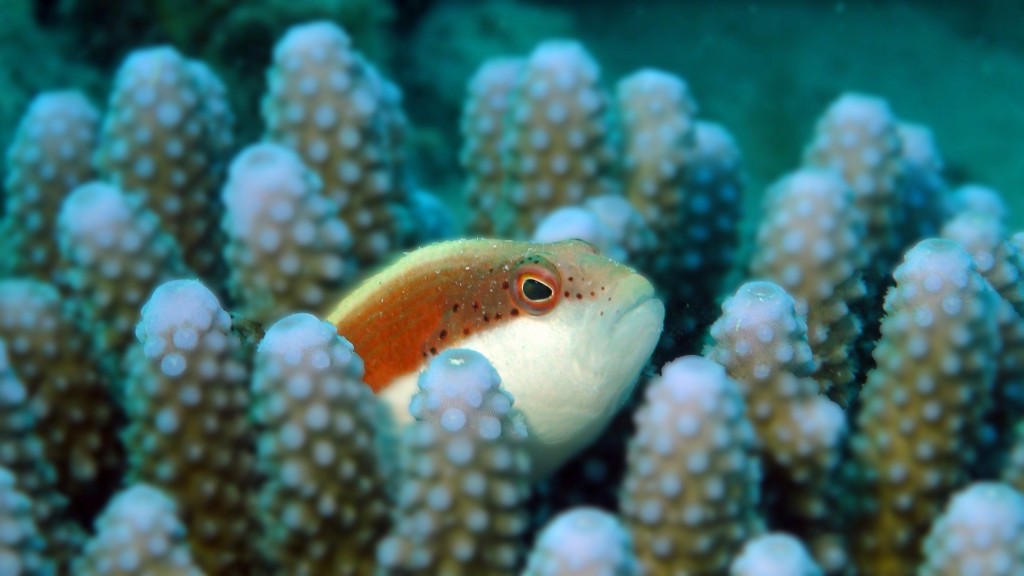Photo / Video News & Reviews
A Guide to Underwater Wildlife Video & Editing: Part 5

Read Part 4 here.
A part serialisation of a book by Jeff Goodman
PART 5: Focus
Most cameras will have an auto focus mode with the option of switching to manual if desired. Unfortunately not all underwater housings will have the controls to let you access this. Some give you a choice of being able to manually change either focus or exposure. If this is the case then I would highly recommend leaving focus on auto and having full manual control over exposure.
Focus is critical to get right.
A picture can be a little too dark or a little too light, or even a little oddly framed, and still be acceptable to most audiences. But a picture that is even slightly out of focus is very hard to accept.
Auto focus
Professional cameras don’t have this option but most others do. Auto focus is a wonderful piece of technology, but no matter how wonderful, it still doesn’t know what you, as a camera person, actually want to focus on. It will take its ‘best guess’ as to what’s right and that generally is what is biggest and most central to your picture frame.
Let’s look at an example of when auto focus can really mess up your videoing.
You are in open water with a dolphin or two. There are no well defined images in the water except the dolphins themselves. Unless the dolphin is large in the frame the auto focus will have a terrible time trying to find an image to resolve itself on. Without the dolphin as a reference in your monitor you may notice that the auto focus is ‘hunting’ in and out trying to find a subject. Often it will settle on focusing on the small bits of dirt or bubbles on your lens port. (Note – always keep your port clean and check it constantly.)
Then a dolphin comes into frame. Will it be sharp? Who knows, it’s pot luck. If you then stay framed on the dolphin long enough, maybe just a few seconds, the auto focus will recognize the image and be happy. Sadly in those first few seconds of video, which may be the most important, the dolphin may not be sharp. Then as soon as the dolphin leaves frame the auto focus will become worried again and may start looking for a new focal point.
This may seem only a minor problem at the time, but believe me, when you get back into the edit room and look at the video, the first few seconds of out-of focus images will drive you crazy. Hence the advantage here of manual focus which you can set yourself.
For this type of shot with the dolphins it usually works out that wide angle framing is best and thus will have a good depth of field. Preset the focus to around 1 to 2 metres. This will generally give sharp images from the lens port to infinity. A point of reference for the pre-focal point could be one of your fins. Simply point the camera down to you feet and focus on the tip of your fin. A brightly coloured one would be most effective. Perhaps use your dive buddy’s bright tank. This pre focus trick can also work quite well for the auto focus especially if you do it moments before the dolphin enters frame.
With manual focus, although you do have greater control over what is sharp, the difficulty arises when you want to zoom in and alter the frame size. Now the 1-2 meter focal point won’t have enough depth of field and so you will have to adjust your focus to compensate. On zooming in the focus becomes much more critical and will have to reflect the true distance of the subject as the depth of field will now be quite small. We look at depth of field later.
With auto focus, zooming in, as long as you remain on the subject, can be very good, but if you are not already framed up on the subject the auto focus will have a devil of a time trying to resolve the image.
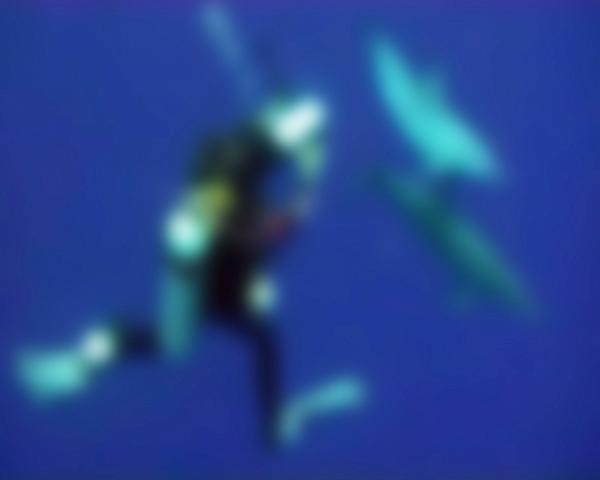
A ‘hunting’ auto focus may give you a ‘soft’ unusable image while all the action is going on regardless.
Here again, as with the dolphin, the auto focus would work very well in a wide angle shot, but as soon as you zoom in to get some close-ups and the depth of field becomes very small, then the clever auto focus is not going to know which part of the frame needs to be kept sharp. The constantly moving fish and also the tentacles of the anemone could keep the auto focus ‘hunting’ throughout your entire shot. Here certainly, the best option is manual focus. If you do not have the option of easily adjusting focus through the housing controls, then keep to the manual option and move the camera in and out slightly as the fish moves, thus keeping it at the correct focal distance. i.e. sharp. There will be many occasions when the auto focus will work just fine and do a brilliant job, but, you are giving over control to an electronic chip. Know it’s limitations.
Not all housings allow you to have full manual control of focus and many don’t allow you to have any control at all. If you only have the auto focus option it’s no problem as long as you are aware of what is going on. With a good clear monitor you can see when a shot is losing focus or not and if it is, then re-think what you are doing and perhaps something as simple as adjusting your shot size will cure the problem.
As we will see later when we discuss editing, it is often desirable to let your subject leave or enter your frame, in this case the clown fish. The downside to this with auto focus is, that as soon as the fish does leave frame, the focus will start hunting for the next best thing to be sharp on. This ‘searching’ even be it for a few moments can look awful and is very different from deliberately changing focus.
So all in all, auto focus is generally very good but can occasionally cause problems which may be acceptable in an amateur video but certainly not in a professional production.
For the lucky ones, some cameras and housings will allow you to change from auto to manual and back again with the flick of a switch or press of a button. Here you have the best of both worlds. Let’s suppose we are filming a turtle on a reef. The first shot you may want to do could be a wide angle and then, adjust shot size, for a close up or two. If there is time, try to zoom right into the turtle and let the auto focus do it’s thing, then flick over to manual focus. The focal distance of the lens will then be locked in place. Now zoom out to the shot size you want and you can be confident that the picture is as sharp as it can possibly be. As the turtle moves you can occasionally, momentarily, flick the auto focus option just to ensure that all is well. How many times you do this is entirely down to your discretion, and lots of practice.

This wide angle image of a reef is spoilt because the auto focus concentrated on the background reef. The red foreground coral is out of focus, even though it is in the key part of the frame.
In the previous example of the coral wide angle, it isn’t of course the fault of the auto focus that the foreground coral is not sharp. You are in charge. Look carefully at what the auto focus is doing. If you don’t like it then turn to manual, re-frame, or don’t do the shot. In this instance it would have been better to have had the red foreground coral sharp, at the expense of the background
Pulling Focus
Pulling focus from one subject to another can be very dramatic, but is mostly effective on long lens shots or at the longer end of your zoom. As we are underwater and most of our videoing is done with a wide angle, pulling focus is not something that is used much at all. However, it can be effective when shooting in close up or macro mode. Here auto focus is next to useless as the shot size and framing will remain constant throughout and the auto focus has no idea that you want to alter the focal point from one part of the frame to another. We definitely want the manual focus option, which needs to be very smooth in its operation, otherwise it will look amateurish.
Next time we look at Lenses, Depth of Field and Angle of Coverage.
Blogs
Jeff Goodman Launches Underwater Moviemaker Course with NovoScuba

Transform Your Dive Experiences into Cinematic Masterpieces
NovoScuba has partnered with acclaimed underwater filmmaker Jeff Goodman to introduce the Underwater Moviemaker Course—a revolutionary program designed to equip divers with the skills to capture the breathtaking beauty of the underwater world.
Whether you’re an aspiring filmmaker, an avid diver, or a photography enthusiast, this course offers the tools and expertise needed to create stunning underwater videos. From vibrant coral reefs to curious marine life, you’ll learn how to film, edit, and produce captivating underwater stories, all with expert guidance from a seasoned professional.
Jeff Goodman: A Legacy in Underwater Filmmaking
Jeff Goodman brings over 40 years of experience in underwater film production for television to this course. Reflecting on his career, Jeff said:
“Although technology has dramatically changed, the basics of underwater filming remain constant. This course covers crucial skills for producing great videos. Whether you’re creating professional broadcast films or high-quality hobby videos, the fundamental principles are the same.
A camera operator must master their equipment to capture those magical underwater moments effortlessly. But beyond technical know-how, underwater filmmaking is about having fun and enhancing your diving experiences. So, take your time, learn at your own pace, and enjoy this creative journey.”
About NovoScuba
Founded in 2023, NovoScuba is reshaping dive education with a comprehensive, digitally native platform. Offering cutting-edge training programs for divers at all levels, NovoScuba sets a new benchmark in the diving industry by combining innovation with accessibility.
With ISO-certified courses, a student subscription model, and multilingual support, NovoScuba ensures that dive education is inclusive and engaging. More than just a training provider, NovoScuba fosters a global community of divers committed to exploration, collaboration, and sustainability.
Join the NovoScuba Underwater Moviemaker Course Today!
Dive into the world of underwater filmmaking and start creating cinematic stories that inspire. Learn more about the course and enroll today at www.novoscuba.com/novoscuba-underwater-moviemaker-course.
EXCLUSIVE: Jeff Goodman interviews Mark Spiers, CEO of New Scuba Diving Training Agency NovoScuba
NovoScuba’s Game-Changing Approach for Dive Store Owners: WE PAY YOU!
The diving world thrives on passion and adventure, but for many dive store owners, the financial and operational challenges can be as deep as the ocean.
NovoScuba, an emerging force in the diving world, is on a mission to transform this landscape for the better. With a revolutionary approach to dive store and training agency partnerships, NovoScuba is setting new standards for how dive stores can thrive while keeping their focus on delivering exceptional diving experiences.

A New Paradigm: NovoScuba’s Bold Mission
NovoScuba’s mission is straightforward yet profound: to disrupt the traditional dynamics between dive store owners and training agencies. Traditionally, dive stores have been subjected to substantial fees charged by training agencies, for membership, materials and certifications. These costs have often placed a heavy financial burden on store owners, cutting into their profits and limiting their ability to offer competitive prices to customers.
NovoScuba flips the script by offering a model where dive stores earn money, instead of paying high fees. Dive stores receive commissions for every student they register, and their certification costs are covered. This new model not only boosts profitability but also ensures clients get top-quality training at unbeatable prices.
Financial Upsides: Earn From Student Registration
NovoScuba’s approach is simple yet revolutionary. Dive stores partnering with NovoScuba can earn commissions for every student they enroll.
Here’s how it works: For every student enrolled through NovoScuba, dive stores receive a commission. Each student enrolled will receive their e-learning materials and certification credit included in their subscription. This arrangement is a significant departure from the traditional model, where dive stores often struggle to manage high overhead costs related to training fees and certification expenses.

NovoScuba’s approach ensures that dive stores can focus on what they do best—providing top-notch diving experiences—without being bogged down by excessive financial burdens, and the need to carry large stocks of materials.
Quality Training at a Great Price
NovoScuba stands out by offering high-quality, ISO certified, training that doesn’t break the bank, in fact our students will pay less than with most competing agencies. Clients benefit from top-notch education and safety standards at competitive prices. Dive store owners can confidently promote NovoScuba’s programs, knowing they’re offering fantastic training at affordable rates. This balance of quality and affordability helps dive stores build a strong reputation and attract more customers.
Your Brand is Your Business: NovoScuba’s Commitment to Showcasing Your Identity
At NovoScuba, we understand that your brand is your most valuable asset, and we’re committed to putting it front and centre. Unlike agencies that charge high fees to promote their own brand, we believe in investing in yours. With NovoScuba, you won’t be paying to advertise someone else’s logo alone, — our focus is on showcasing your unique identity. Certifications prominently feature your brand, as well as the training agency, reinforcing your store’s image and brand every step of the way. We’re here to support and elevate your brand, ensuring that your investment directly benefits your business.
Affordable Membership: An Investment in Your Success
NovoScuba’s membership model is designed with dive store owners in mind. Membership fees are kept low and include annual Pro member fees for your team. Payment can be made monthly or annually in your local currency, avoiding the hassle of exchange rate fluctuations. NovoScuba promises no exchange rate changes without a six-month notice, ensuring financial stability and simplifying budgeting. With a membership lasting 12 months from date of joining, you’ll enjoy a full year of NovoScuba’s benefits and support.

Streamlined Operations: Simplifying Your Workload
Handling administrative tasks can be a challenge, but NovoScuba makes it easier. We’ve streamlined certification procedures and reduced paperwork to help dive stores operate more efficiently. Certification processing is quick and straightforward, allowing more focus on teaching and customer service. Our system minimises bureaucracy by storing necessary forms in student profiles, reducing paperwork and administrative delays.
Crossover Made Easy
For dive stores looking to transition to NovoScuba’s model, the crossover process is designed to be smooth and hassle-free. NovoScuba provides support to ensure that the transition is as seamless as possible, helping dive store owners integrate into the new system with minimal disruption. Experienced dive Pros don’t need to undergo extensive retraining. Our crossover is designed to familiarise Pros with NovoScuba’s user-friendly platform, standards and course structures, and not to waste time and expense re-training in water.
With just a few simple steps, you’ll be ready to offer top-notch training through NovoScuba.
Comprehensive Business Support and Training Included in Your Membership
NovoScuba goes beyond financial benefits by offering experienced support and training. This value added service includes:
- Business Training: Optimise your operations with guidance on marketing, customer service, and best practices.
- Marketing and Promotion: Access resources to attract new customers and boost your store’s visibility. Enjoy cross promotions with NovoScuba to gain increased exposure.
- Ongoing Support: NovoScuba’s commitment to its partners extends beyond initial training and setup. The company offers ongoing support to address any issues or questions that arise. This continuous support ensures that dive store owners have a reliable resource to turn to whenever they need assistance.

Embracing Digital Natives: Instant Evolution and Continuous Improvement
NovoScuba’s digital-native approach is a game-changer. Leveraging cutting-edge technology, we ensure our services evolve and improve swiftly. Dive stores benefit from instant updates, the latest features, enhancements, and effective solutions, keeping them ahead of the curve. This continuous improvement helps dive stores stay competitive and deliver exceptional services. Whether it’s a new course update, additional marketing resources, or improved e-learning functions, NovoScuba’s digital infrastructure ensures that dive stores are always equipped with the most current and effective solutions. This continuous evolution not only helps dive stores stay ahead in a competitive market but also ensures they consistently provide top-quality services to their clients.
Why Is NovoScuba Doing This? – Fair Profit Sharing for Greater Access and Growth
At NovoScuba, we’ve taken a bold step by paying commissions to stores rather than following the traditional model of training agencies charging high fees. Our mission is to make diving accessible to everyone and to foster a growing community of new divers and continued education. By redistributing profits more equitably between stores and training agencies, we aim to create a more supportive and collaborative environment within the industry. We believe this approach not only helps individual stores thrive but also stimulates overall growth and innovation in diving. Our commitment to fair profit sharing reflects our dedication to the long-term health and expansion of the diving community.

Everyone is getting a piece of the pie.
Getting Started: Join the NovoScuba Revolution
Ready to revolutionise your dive store experience? NovoScuba is here to support your journey toward reduced costs, increased profitability, and enhanced operational efficiency. Get in touch with our team to learn how NovoScuba can transform your business.
For more information, email info@novoscuba.com or visit www.novoscuba.academy.
Blogs
The Benefits of Underwater Photography Workshops

Are you just getting started out in underwater photography or are you a seasoned shooter who wants to take their images to the next level? Whatever you experience or ability, here’s an overview of underwater photography workshops.
What is an Underwater Photography Workshop?
The first thing to note is that this is not ‘school’! There are no compulsory classes and at workshops you are free to pick and choose what you take part in, or otherwise.
A huge part of learning and developing your skills is through experimentation, trial and error, responding to feedback, and honing your technique. Underwater photography workshops provide you with the perfect platform for practice and improvement.
There is no better alternative to hands on experience in an environment that is 100% dedicated to your development. Reading informative articles and watching videos on YouTube can never replace the value of one on one time with your camera rig, underwater!
Underwater photography workshops are generally structured around core components, namely: presentations, underwater practice, feedback and critique sessions, troubleshooting/one-on-one sessions, and technical support.
Other components of a workshop include dining, relaxing, and time for socializing too!

What Topics do Underwater Photography Workshops Cover?
Depending on the pro, the type of workshop and regional diving highlights, a wide range of topics may be covered from composition and lighting through to shooting techniques and editing.
Benefits of an Underwater Photography Workshop
- Improve Your underwater photography
- Learn from professionals
- Learn from other participants
- Expand your photography knowledge and understanding
- Try put new techniques
- Learn how to maximize your camera rig
- Phenomenal travel opportunities
- Memorable experience and new friendships

Underwater Photography Workshops in the Lembeh Strait, Indonesia
When it comes to underwater photography workshops that focus on shooting macro, muck diving, and unusual marine species, there can be no better destination on the planet than the Lembeh Strait.
The Critter Capital of the World, a Muck Diving Mecca, and the Twilight Zone are just a few of the names that have been given to this stretch of water over the years due to its high density, and diversity, of rare and unusual marine life.
Some of Lembeh’s most iconic species include the hairy frogfish, Pontohi pygmy seahorse, the Lembeh sea dragon, Mandarin fish, Bobbit worms, Rhinopias scorpionfish, flamboyant cuttlefish, tiger and harlequin shrimps, ornate ghost pipefish, harlequin crabs, and where do we start with octopus? Here’s just a few… wunderpus, mimic, blue ring, hairy, long arm, starry night, and coconut… and the list goes on!
Dive conditions in the Lembeh Strait can be extremely favourable for underwater photographers. There is little to no current making both moving around and remaining stationary a breeze. The comfortably warm water temperatures reduce the cold that can also set in when not on the move.
Lembeh Resort and Underwater Photography Workshops
Lembeh Resort not only offers luxury accommodation in the Lembeh Strait but it is also offers a complete suite of facilities for underwater photographers and enthusiasts. Here is a ‘snapshot’ of the camera and imaging services that are on offer at Lembeh Resort – inside and outside of underwater photography workshops:
Photography Facilities
Lembeh Resort offers a suite of facilities for underwater photographers, including:
- The only Backscatter Authorized Photo Center in Asia
- Photo Center offering camera, housing, lights and accessory rentals and purchases, onsite repairs, onsite 3D printing of small components, professional support and assistance, full workshop support
- Full time onsite Photo Pro
- Full time onsite Marine Biologists
- Marine biology and underwater photography trained Dive Guides
- Spacious camera room with individual work spaces, lights, and power points
- Varied diving options including single dives in the Lembeh Strait, two or three tank dive trips, day trips to Bangka, east coast Lembeh trips, blackwater, bonfire, night, and Mandarin fish dives.

Capturing Critters in Lembeh Underwater Photography Workshop 2025
The renowned Capturing Critters in Lembeh Underwater Photography Workshop is back in January 2025 for the 12th year running!! This unique workshop is hosted by not one but three worldclass photo professionals. The 2025 workshop features: Ron Watkins (USA), Paul Duxfield (UK), and Renee Capozzola (USA). The week-long workshop promises to be packed with incredible diving, Pro presentations, and one-on-one instruction and feedback.
2025 Workshop Schedule and Dates:
- Pre-Workshop: January 8th ––10th (time to relax and unwind after traveling and enjoy some of Lembeh’s famous dive sites.)
- Workshop: January 11th – 17th (Capturing Critters in Lembeh 12th Annual Workshop)
- Workshop Extension: January 18th – 19th (Additional Day Workshop Extension)
- Post-Workshop: January 20th – 21st (Stay additional nights and enjoy extra diving days or some time to relax and explore more of North Sulawesi)
Find Out More:
Meet the pros and find out more about the Capturing Critters in Lembeh 2025 underwater photography workshop, including prices and workshop inclusions, here:
If you are ready to book your place on the January 2025 Capturing Critters in Lembeh Underwater Photography Workshop – contact Lembeh Resort at: reservations@LembehResort.com.
-

 News2 months ago
News2 months agoIconic SS United States to become the World’s Largest Artificial Reef
-

 News3 months ago
News3 months agoBook Review – 52 Assignments: Underwater Photography
-

 Gear News3 months ago
Gear News3 months agoDYNAMICNORD – New German diving brand enters the British market
-

 News3 months ago
News3 months agoExploring Cenote El Pit: A Diver’s Dream
-

 Gear News3 months ago
Gear News3 months agoTry BARE drysuits (and maybe even win one!) this Friday with Sea & Sea at North West Dive Fest
-

 Marine Life & Conservation3 months ago
Marine Life & Conservation3 months agoBook Review: Coral Triangle Cameos
-

 Blogs2 months ago
Blogs2 months agoDive the Egyptian Red Sea this Autumn with Regaldive
-

 News3 months ago
News3 months ago2024 Ocean Art Underwater Photo Competition Announced


